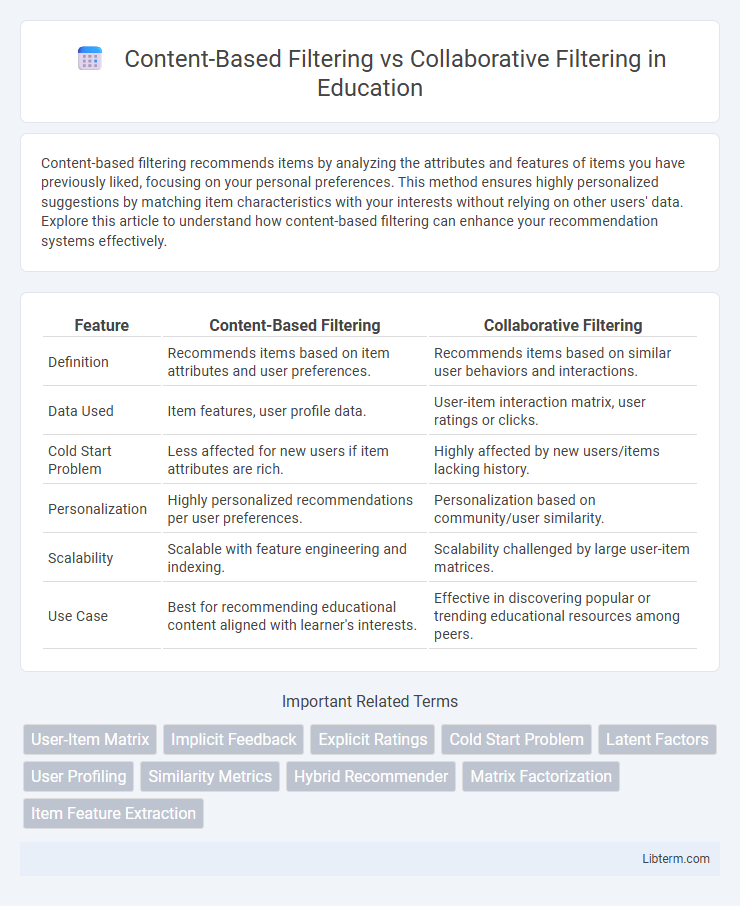Content-based filtering recommends items by analyzing the attributes and features of items you have previously liked, focusing on your personal preferences. This method ensures highly personalized suggestions by matching item characteristics with your interests without relying on other users' data. Explore this article to understand how content-based filtering can enhance your recommendation systems effectively.
Table of Comparison
| Feature | Content-Based Filtering | Collaborative Filtering |
|---|---|---|
| Definition | Recommends items based on item attributes and user preferences. | Recommends items based on similar user behaviors and interactions. |
| Data Used | Item features, user profile data. | User-item interaction matrix, user ratings or clicks. |
| Cold Start Problem | Less affected for new users if item attributes are rich. | Highly affected by new users/items lacking history. |
| Personalization | Highly personalized recommendations per user preferences. | Personalization based on community/user similarity. |
| Scalability | Scalable with feature engineering and indexing. | Scalability challenged by large user-item matrices. |
| Use Case | Best for recommending educational content aligned with learner's interests. | Effective in discovering popular or trending educational resources among peers. |
Introduction to Recommendation Systems
Content-Based Filtering leverages user preferences and item attributes to recommend similar items based on past behavior, utilizing algorithms like cosine similarity or TF-IDF for accurate personalization. Collaborative Filtering, on the other hand, analyzes user interactions across a community to identify patterns and suggest items favored by similar users, employing techniques such as user-based and item-based k-nearest neighbors or matrix factorization. Both approaches form the foundation of modern recommendation systems, enhancing user experience by predicting relevant content effectively.
What is Content-Based Filtering?
Content-Based Filtering is a recommendation technique that analyzes item features and user preferences to suggest similar products or content. It relies on descriptive attributes such as genre, keywords, or user ratings to match new items with a user's past interactions. This approach personalizes recommendations by focusing solely on the individual user's history and item characteristics without considering other users' data.
How Does Collaborative Filtering Work?
Collaborative filtering works by analyzing user behavior patterns and preferences to recommend items based on the interests of similar users. It uses algorithms such as user-user or item-item similarity matrices, leveraging historical interaction data like ratings, purchases, or clicks to predict preferences. By identifying correlations between users or items, collaborative filtering provides personalized recommendations without requiring explicit content information.
Key Differences Between Content-Based and Collaborative Filtering
Content-based filtering relies on analyzing item features and user preferences to recommend similar items, while collaborative filtering leverages user interactions and behavior patterns to suggest items based on similarities among users. Content-based methods excel in addressing the cold-start problem for new users or items by using detailed metadata, whereas collaborative filtering requires a substantial amount of user interaction data to generate accurate recommendations. Collaborative filtering can capture complex user-item relationships through techniques like matrix factorization and neighborhood models, contrasting with content-based filtering's dependence on explicit item attributes.
Advantages of Content-Based Filtering
Content-based filtering excels in recommending items by analyzing a user's past preferences and item attributes, ensuring personalized suggestions without requiring data from other users. This approach addresses the cold-start problem for new users or items by relying on content features rather than user interactions. It also provides transparency in recommendations, allowing users to understand why specific items are suggested based on shared characteristics.
Benefits of Collaborative Filtering
Collaborative filtering leverages user interaction data to provide highly personalized recommendations by identifying patterns across a large user base. It excels in discovering new and diverse content that users with similar preferences have enjoyed, enhancing recommendation accuracy without requiring detailed item metadata. This approach adapts dynamically to changing user tastes, resulting in continuous improvement of recommendation relevance over time.
Limitations and Challenges of Each Approach
Content-based filtering often suffers from limited content analysis capabilities, leading to over-specialization and reduced recommendation diversity, while relying heavily on high-quality, structured item data. Collaborative filtering faces challenges like the cold-start problem for new users or items, data sparsity, and vulnerability to popularity bias, which can skew recommendations toward well-known items. Both approaches struggle with scalability and maintaining accuracy in dynamic, large-scale systems with diverse user preferences.
Use Cases and Industry Applications
Content-based filtering excels in personalized recommendations for niche e-commerce platforms and streaming services by analyzing user preferences and item features, enhancing customer experience through tailored suggestions. Collaborative filtering proves highly effective in social media, online marketplaces, and entertainment industries by leveraging user behavior and community data to identify similar user patterns and predict interests. Both techniques are integral in sectors like retail, digital advertising, and online education, where adaptive recommendation systems drive engagement and increase conversion rates.
Hybrid Recommendation Systems
Hybrid recommendation systems combine content-based filtering, which analyzes item attributes and user preferences, with collaborative filtering, which utilizes user behavior patterns and interactions to enhance accuracy. This integration addresses limitations like cold start and sparsity by leveraging multiple data sources, improving recommendation relevance and diversity. Effective hybrid models employ techniques such as weighted, switching, and feature augmentation to deliver personalized user experiences across various domains like e-commerce and streaming services.
Choosing the Right Filtering Method for Your Needs
Content-Based Filtering leverages user preferences and item attributes to recommend similar items, making it ideal for niche markets with rich item metadata. Collaborative Filtering analyzes user behavior patterns and interactions, excelling in environments with large user bases and diverse activity data. Selecting the right method depends on data availability and the recommendation context, with hybrid approaches often enhancing accuracy by combining both techniques.
Content-Based Filtering Infographic

 libterm.com
libterm.com